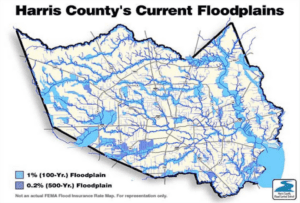 On Wednesday, the Houston City Council voted on Mayor Turner’s proposed floodplain ordinance. Beginning in September 2018, new construction must be built two feet above ground level, elevating homes and commercial buildings out of the 500-year floodplain. Prior to Hurricane Harvey, new construction only required one-foot elevation above the 100-year flood zone.
On Wednesday, the Houston City Council voted on Mayor Turner’s proposed floodplain ordinance. Beginning in September 2018, new construction must be built two feet above ground level, elevating homes and commercial buildings out of the 500-year floodplain. Prior to Hurricane Harvey, new construction only required one-foot elevation above the 100-year flood zone.
Since 2015, the city has experienced three “500-year” floods. On Memorial Day 2015, Houston received approximately twelve inches of rain in ten hours. Eleven months later, the “Tax Day Flood” caused over $1 billion in property damage. In August 2017, the rainfall from Hurricane Harvey caused immense damage across Harris County and Houston. Ranked as the second-most costly hurricane to hit the United States mainland, approximately thirteen million individuals were affected and nearly 135,000 homes were damaged or destroyed.
Importantly, a 100, 300 or 500-year flood does not indicate the approximate timing of the next major rain event. A 500-year flood is one that has a 1 in 500 chance of occurring in any given year. Similarly, a 100-year flood has a 1 in 100 chance of occurring. According to the National Weather Service, for a 500-year flood, there is a 0.2 percent chance of having a flood of that magnitude occurring in any given year.
In a tight 9-7 vote, the ordinance implements minimum elevation requirements within the 500-year floodplain. This will affect new construction, as well as existing homes that must be significantly renovated. Existing homes, and those who receive their permit before the September 1st date, are grandfathered into the ruling and will not be required to elevate. According to the City, changes will affect approximately 86,000 properties. While this is an important step, it’s unfortunate that the City will not require all new builds to construct vulnerable properties to the updated elevation minimums. Elevating the floodplain ordinance is a critical step for resilient communities across our area.
